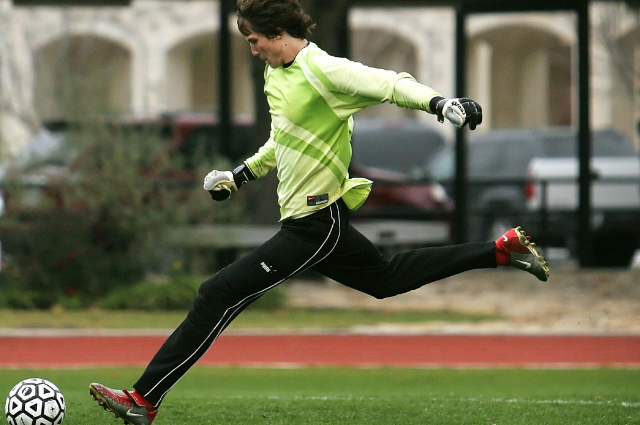
There is no walk in football more terrifying than the one from the halfway line to the penalty spot. Forty yards can feel like forty miles. The crowd blurs, the ball seems to shrink, and your heartbeat drowns out everything else. By the time the whistle blows, you’re not just kicking a ball—you’re fighting your own nervous system.
Penalty shootouts look simple. They aren’t. They are psychology laid bare.
Stress: When the Body Betrays the Brain
Sports scientists have studied this for years. Under stress, muscles tighten, movements lose fluidity, and control breaks down. The term is “choking,” but it isn’t just a cliché—it’s biology. High cortisol levels disrupt fine motor control, producing rushed, stiff, unnatural shots.
Roberto Baggio’s infamous miss in the 1994 World Cup final wasn’t due to lack of skill—he had carried Italy to that point. But the weight of the moment tightened every muscle. His strike flew into the Pasadena sky, etched forever in memory.
Now compare Zidane in 2006. World Cup final. Gianluigi Buffon in goal. Zidane chipped a Panenka off the underside of the bar—calmness bordering on arrogance. Skill? Yes. But more importantly, serenity under crushing pressure. Same stage, two very different psychological states.
Hidden Biases in High-Stakes Moments
Pressure scrambles thought, allowing hidden biases to creep in.
- Action Bias (Goalkeepers): Keepers almost always dive left or right, even though statistics show staying central is often most effective. Why? Because action looks better than inaction, even if logic says otherwise.
- Gambler’s Fallacy (Shooters): Players believe patterns must “balance.” If three shots go left, the fourth “must” go right. But each kick is independent—our brains just hate randomness.
- Order Effect: Teams that shoot first win about 60% of the time. It’s not magic—it’s momentum. Chasing amplifies pressure with every miss.
- Spotlight Effect: Players feel as though the entire world is dissecting their every twitch. For fans, a miss is heartbreak. For the taker, it feels like a permanent scar.
The Keeper’s Theatre
If shooters fight themselves, goalkeepers fight psychology head-on.
Jerzy Dudek’s “spaghetti legs” in Istanbul 2005 were chaos weaponized. Serginho, rattled, blasted into the stands. Emiliano Martínez in Qatar 2022 turned penalties into street theatre—stalling, trash-talking, pointing to corners. He saved two, Argentina won.
Even subtler tricks matter. A keeper standing just slightly off-center can fool a player into shooting at the side that appears larger. A single foot’s difference can alter decisions.
Culture and Collective Memory
Penalty shootouts carry history and national narratives.
- England: Southgate’s miss in 1996, Beckham in 2004, Saka in 2020—all fed into a storyline of national failure. Players carried not just their own pressure, but the ghosts of those before them.
- Germany: The opposite. With one of the best shootout records, their culture treats penalties as routine. No curses, no baggage—just practice until confidence is automatic.
- Panama: Coaches once blasted insults through megaphones during training to simulate pressure. When the real moment came, their players looked unshakably calm.
The Walk: Football’s Longest Journey
That lonely stretch from halfway to the penalty spot is often decisive. Studies by Geir Jordet show heart rates spiking above 160 bpm before the kick. Tunnel vision sets in, and peripheral awareness fades.
Body language is telling. Jordet found that players who walked quickly, head down, with minimal glances, scored more often. Those who strolled slowly or stared at the keeper missed more. Sometimes you could see the outcome in their gait before they even touched the ball.
Training for the Inevitable
Modern football accepts that shootouts are not lotteries—they are skill under pressure.
Clubs like Brentford analyze keeper tendencies.
National teams rehearse penalties with artificial crowd noise.
Liverpool even tested eye-tracking tech to stabilize gaze control.
Individual rituals—Ronaldo’s wide stance, Jorginho’s hop, Messi’s pause—aren’t just quirks. Psychologists see them as anchors, designed to block intrusive thoughts.
Collapse and Redemption
Penalties fascinate not just because of goals or misses, but because of what they reveal.
Kylian Mbappé’s miss at Euro 2021 was shocking because a generational talent suddenly looked vulnerable. Yet Bukayo Saka’s redemption in Euro 2024—scoring after his Euro 2020 heartbreak—reminded us that shootouts can rebuild as much as they destroy.
Why We Can’t Look Away
Shootouts condense football into its rawest form: fear, doubt, nerve, courage. No formations, no tactics—just the psyche exposed at eleven meters. Stress hormones against training. Bias against logic. History against the present.
Sometimes the ball goes in. Sometimes it doesn’t. But it’s never random. That’s why we watch.
Penalty shootouts are not games of chance but crucibles of psychology. Composure, memory, and resilience weigh as heavily as technique. Each step to the spot is a meditation on fear and courage; each strike, a duel not just with the goalkeeper but with the self.
For the player, the penalty is execution and existential reckoning. For the spectator, it is distilled theatre—football stripped bare, reduced to the primal contest between nerve and collapse. Within those eleven meters lies a paradox: the sport at once most brutal, and most beautiful.
